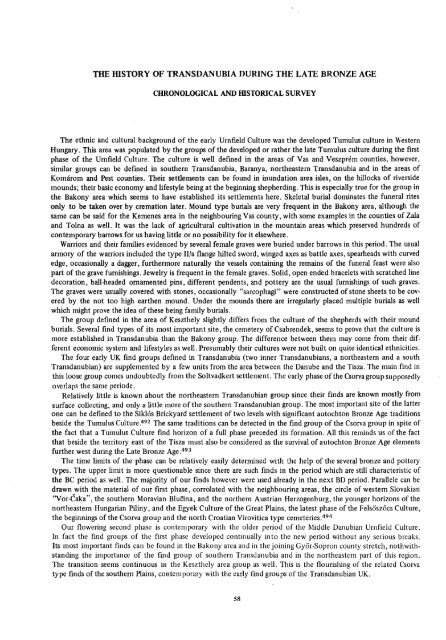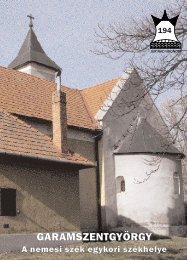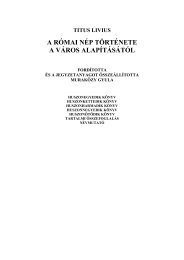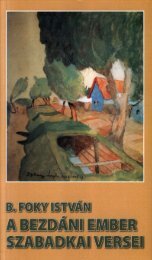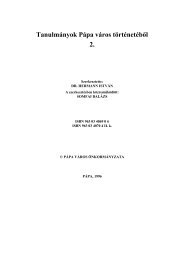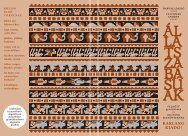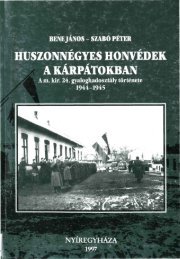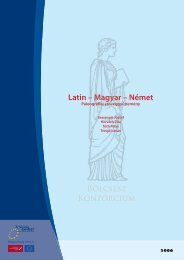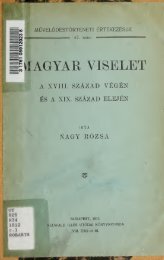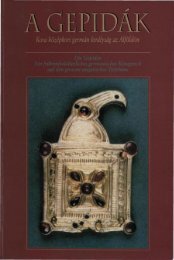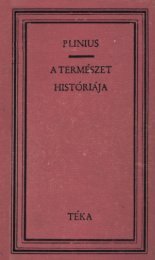A Dunántúl Története A KésÅbronzkorban (BTM műhely 1. kötet ...
A Dunántúl Története A KésÅbronzkorban (BTM műhely 1. kötet ...
A Dunántúl Története A KésÅbronzkorban (BTM műhely 1. kötet ...
Create successful ePaper yourself
Turn your PDF publications into a flip-book with our unique Google optimized e-Paper software.
THE HISTORY OF TRANSDANUBIA DURING THE LATE BRONZE AGE<br />
CHRONOLOGICAL AND HISTORICAL SURVEY<br />
The ethnic and cultural background of the early Urnfield Culture was the developed Tumulus culture in Western<br />
Hungary. This area was populated by the groups of the developed or rather the late Tumulus culture during the first<br />
phase of the Urnfield Culture. The culture is well defined in the areas of Vas and Veszprém counties, however,<br />
similar groups can be defined in southern Transdanubia, Baranya, northeastern Transdanubia and in the areas of<br />
Komárom and Pest counties. Their settlements can be found in inundation area isles, on the hillocks of riverside<br />
mounds; their basic economy and lifestyle being at the beginning shepherding. This is especially true for the group in<br />
the Bakony area which seems to have established its settlements here. Skeletal burial dominates the funeral rites<br />
only to be taken over by cremation later. Mound type burials are very frequent in the Bakony area, although the<br />
same can be said for the Kemenes area in the neighbouring Vas county, with some examples in the counties of Zala<br />
and Tolna as well. It was the lack of agricultural cultivation in the mountain areas which preserved hundreds of<br />
contemporary barrows for us having little or no possibility for it elsewhere.<br />
Warriors and their families evidenced by several female graves were buried under barrows in this period. The usual<br />
armory of the warriors included the type Il/a flange hilted sword, winged axes as battle axes, spearheads with curved<br />
edge, occasionally a dagger, furthermore naturally the vessels containing the remains of the funeral feast were also<br />
part of the grave furnishings. Jewelry is frequent in the female graves. Solid, open ended bracelets with scratched line<br />
decoration, ball-headed ornamented pins, different pendents, and pottery are the usual furnishings of such graves.<br />
The graves were usually covered with stones, occasionally "sarcophagi" were constructed of stone sheets to be covered<br />
by the not too high earthen mound. Under the mounds there are irregularly placed multiple burials as well<br />
which might prove the idea of these being family burials.<br />
The group defined in the area of Keszthely slightly differs from the culture of the shepherds with their mound<br />
burials. Several find types of its most important site, the cemetery of Csabrendek, seems to prove that the culture is<br />
more established in Transdanubia than the Bakony group. The difference between them may come from their different<br />
economic system and lifestyles as well. Presumably their cultures were not built on quite identical ethnicities.<br />
The four early UK find groups defined in Transdanubia (two inner Transdanubians, a northeastern and a south<br />
Transdanubian) are supplemented by a few units from the area between the Danube and the Tisza. The main find in<br />
this loose group comes undoubtedly from the Soltvadkert settlement. The early phase of the Csórva group supposedly<br />
overlaps the same période.<br />
Relatively little is known about the northeastern Transdanubian group since their finds are known mostly from<br />
surface collecting, and only a little more of the southern Transdanubian group. The most important site of the latter<br />
one can be defined to the Siklós Brickyard settlement of two levels with significant autochton Bronze Age traditions<br />
beside the Tumulus Culture. 492<br />
The same traditions can be detected in the find group of the Csórva group in spite of<br />
the fact that a Tumulus Culture find horizon of a full phase preceded its formation. All this reminds us of the fact<br />
that beside the territory east of the Tisza must also be considered as the survival of autochton Bronze Age elements<br />
further west during the Late Bronze Age. 493<br />
The time limits of the phase can be relatively easily determined with the help of the several bronze and pottery<br />
types. The upper limit is more questionable since there are such finds in the period which are still characteristic of<br />
the BC period as well. The majority of our finds however were used already in the next BD period. Parallele can be<br />
drawn with the material of our first phase, corrolated with the neighbouring areas, the circle of western Slovakian<br />
"Vor-Caka", the southern Moravian Bluöina, and the northern Austrian Herzogenburg, the younger horizons of the<br />
northeastern Hungarian Piliny, and the Egyek Culture of the Great Plains, the latest phase of the Felsőszőcs Culture,<br />
the beginnings of the Csórva group and the north Croatian Virovitica type cemeteries. 494<br />
Our flowering second phase is contemporary with the older period of the Middle Danubian Urnfield Culture.<br />
In fact the find groups of the first phase developed continually into the new period without any serious breaks.<br />
Its most important finds can be found in the Bakony area and in the joining Győr-Sopron county stretch, notwithstanding<br />
the importance of the find group of southern Transdanubia and in the northeastern part of this region.<br />
The transition seems continuous in the Keszthely area group as well. This is the flourishing of the related Csórva<br />
type finds of the southern Plains, contemporary with the early find groups of the Transdanubian UK.


